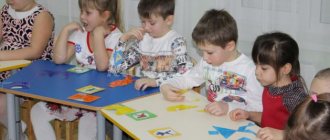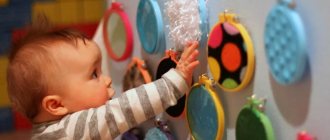Preschool age is a time when the cognitive, moral, and physical development of a child occurs especially intensively. In particular, it is before the age of 5-6 that a child acquires more than half of the total thinking skills that will be useful to him in the future. That is why it needs to be given special attention. In particular, it is at this age that the child should develop his first mathematical skills. Let's consider the theoretical foundations of the mathematical development of children of junior and senior preschool age.
Math lesson in kindergarten, senior group
Why is this so important?
- Mathematics is one of the most significant subjects. However, it is precisely this that often causes considerable difficulties for students.
- Studying this subject has a beneficial effect on the child’s cognitive abilities (thinking, memory, speech)
- Mathematical skills improve the emotional-volitional sphere, form perseverance and determination
- Improves the basics of a child's imagination
The role of mathematics in life
What skills should a child develop by the end of the preschool period?
By the end of the preschool period, the child should have the following mathematical skills:
- Ability to compare values based on basic characteristics; the formation of ideas about the concepts of “more-less”, “higher-lower”, etc.
- The ability to group objects according to their basic properties (basics - size, color, purpose, material, shape)
- Ability to compare parts and wholes; ability to assemble a picture from at least 12-24 fragments
- Developed counting skills and the ability to perform mathematical operations with numbers within ten
- Children’s development of quantitative and qualitative representations of the subject
The essence of mathematical development
Necessary conditions for conducting math classes with a child
What is the theory and methodology of mathematical development for preschoolers based on? In order for the lessons to be truly interesting for the child, and for him to assimilate information faster and easier, they must be built taking into account the following recommendations:
- The use of visual didactic material selected taking into account the age and other individual characteristics of the child
- The presence of a clear plot for the lesson according to which its development will take place
- Selection of tasks in strict accordance with the age characteristics of the child and the level of his intellectual development
- Using a variety of methods and forms to create the basis of work (these include solving logical problems, didactic games, working with handouts, etc.)
- Multitasking (focus on the development of spatial, temporal, quantitative concepts)
- Using a game form of conducting classes
- Emphasis on the formation of gaming motivation; elements of surprise and surprise
- Helping the child not only master a certain system of knowledge and skills, but also develop his skills of independent cognitive activity, independence of judgment, etc.
- Formation of an optimal developmental environment for the development of basic cognitive processes in a child
- Teaching children to perceive the quantitative and qualitative features of objects, forming appropriate ideas
Objectives for the development of mathematical abilities
Principles of mathematical learning and development of preschoolers
The method of mathematical development of a child is based on the following principles of mathematical teaching and development of preschool children:
- The principle of visualization of learning . Training will be effective when using visual teaching aids that meet the age and individual characteristics of children’s cognitive development and perception of information.
- The principle of clarity in organizing classes . Mathematics classes should have a clear structure. The plot of the game and the sequence of actions must have a clear structure in accordance with which the development of the preschooler will take place.
- The principle of relying on developmental psychology . Mathematical learning tasks should be developed in accordance with the age-related characteristics of the child’s development, his needs and capabilities of mathematical perception.
- The principle of learning variability . It is necessary to use different methods and means of forming the child’s mathematical concepts and ideas. This can be gaming activities, logical tasks, exercises of a creative nature, but with a logical focus, etc.
- The principle of multitasking learning. In the course of studying mathematics, one should focus not only on the formation of elementary mathematical concepts in the child, but also on the development of spatial perception,
- The principle of game learning . It is important to implement the mathematical development of preschoolers in a playful form, since play is the leading activity of preschoolers. The game motivates to learn. It contains an element of surprise, captivates and develops interest in mathematics.
- The principle of orientation towards the development of cognitive activity . The child must develop not just mathematical knowledge, but also a desire to independently study mathematical science and form logical judgments and conclusions.
- The principle of creating a developing space . In preschool educational institutions, a subject-development environment is created in which fundamental cognitive processes are formed.
- The principle of development of perception of quantitative and qualitative characteristics of objects . If a child masters the differences between objects based on quantitative and qualitative characteristics, this will lay the foundation for the formation of mathematical concepts.
Features of the formation of mathematical concepts depending on age
Considering that preschool age is conventionally divided into three main periods, goals, objectives, as well as methods and forms of mathematical education of children will also differ.
Junior preschool period. At this time, the necessary mathematical skills and concepts are just beginning to develop. Therefore, the child needs to be given an idea of basic operations. The best games for developing thinking skills are children's mosaics (from 5 fragments), addition of geometric shapes (from 4 parts). The method of developing quantitative and qualitative concepts in preschoolers requires special attention.
Middle preschool period. There is an active development of the sign-symbolic function of consciousness. The child can already be taught to count and the simplest mathematical operations. The foundations of logical thinking are laid. The most preferred games include: “Nonsense”, “Count the objects”, “Find a pair”, “Mathematical lotto”, “Domino figures”. To develop a child’s analytical and synthetic abilities, you can offer him games like tangram, where he will need to make a geometric figure, a silhouette of an animal, etc. from individual parts.
Individual lesson to determine the level of mathematical development
In older preschool age, the child’s independence and his ability to self-organize begin to play an increasingly noticeable and significant role. Logical thinking is becoming increasingly important.
The child begins to try to compose stories from pictures, compose logical series, observing the correct sequence of elements.
Math tests for kids 3-4 years old
Methods of mathematical development as a science
Definition 1
Methodology of mathematical development is a branch of scientific knowledge that studies the processes of development of the cognitive sphere of children and the formation in them of the foundations of logical thinking and skills in performing elementary mathematical operations.
The methodology of mathematical development is focused on the formation of elementary mathematical concepts in preschoolers. She develops a methodology for their formation and determines the patterns of functioning of different areas of thinking and logic, which affect the overall development of the individual and the mastery of mathematical science.
Mathematical development is important for a child's overall development. Therefore, teaching mathematics occupies the core of the preschool educational program. Mathematical concepts activate the cognitive activity of a preschooler and develop his thinking abilities.
Are you an expert in this subject area? We invite you to become the author of the Directory Working Conditions
The methodology of mathematical development, as a science, is aimed at developing elementary mathematical concepts in children. This determines the following tasks of the methodology of mathematical development:
- Scientific confirmation of the level of mathematical development of preschool children at each stage of their development and the requirements for children to master the educational program.
- Development of the content of a preschool educational program in the area of mathematical education and development.
- Determination of optimal means and methods, technologies and forms of teaching preschoolers the basics of mathematics.
- Creating conditions for continuity in mathematical education of preschoolers and primary schoolchildren.
- Preparing teachers for professional activities in the field of mathematical education and development of preschool children.
- Development of recommendations for the mathematical development of a child by parents.
- Development of the main directions of cognitive activity, focused on the child’s mathematical development when engaged in different types of activities (work, sports, etc.).
Finished works on a similar topic
Course work Methodology of mathematical development 420 ₽ Abstract Methodology of mathematical development 220 ₽ Examination Methodology of mathematical development 210 ₽
Receive completed work or specialist advice on your educational project Find out the cost
Since the methodology of mathematical development is a scientific branch, it has connections with other sciences. It is closely related to developmental psychology, which determines the functioning of a child’s mental processes, sensitive periods of development of specific areas, and helps in developing optimal methods for the formation of elementary mathematical concepts in preschoolers of different age groups. In addition, the methodology of mathematical development is closely related to pedagogy. This connection can be traced in the reliance of this science on didactic methods and principles of teaching children mathematics.
In addition, there is a connection between this scientific field and sociology, anthropology, mathematics, special pedagogy and cultural studies.
The subject of the methodology of mathematical development is teaching mathematics, implemented in certain forms and focused on achieving specific goals and objectives.
The object of research into the methodology of mathematical development is the methods and means of mathematical teaching used in the preschool education system.
What methods are best used to develop a preschooler's mathematical understanding?
The visual method plays the most important role in teaching children mathematics, especially when it comes to the early preschool period.
Methods for developing mathematical knowledge
There are the following types of visual teaching methods:
- Working with handouts or demonstration materials. Using a plotless or plot method (you can take as a basis the plot of any fairy tale familiar to a child, where counting or numbers would appear)
- Volumetric or planar. Classes using special counting materials (for example, children's abacus, sticks, cubes, etc.)
- Homemade or factory made.
Handouts for mathematical classes
In order to use visual material more effectively, it is necessary to build developmental classes taking into account the following patterns:
- The study of each new topic should begin with more voluminous visual material. This will make it easier for the child to understand
- As the child grows up, it is necessary to ensure that the proportion of volumetric and plot-based visual material decreases, and the proportion of flat and plotless material increases
- It is advisable to use several types of visual material to solve one software problem
- It is very advisable to familiarize the child with new material in advance.
Separately, it is worth considering the requirements for visual aids.
Didactic material for classes
As we have already indicated above, it can be either ready-made at the factory or made by parents. However, it is important that it matches the following:
- Hygiene. Toys must be made from environmentally friendly, safe materials and have all the necessary certificates
- Aesthetics. Attractive material is more likely to attract the child's attention
- A reality that allows a child to perceive the material being studied without distortion
- Durability and reliability
- Variety and sufficient quantity to allow the use of variable techniques
- The principle of logical construction that combines the basics of the material
- Uniformity
Play corner with didactic materials
A significant advantage of the practical teaching method is that it most fully explains to the child why he is studying this or that material. And how exactly will the knowledge gained be useful to him in the future?
- Active application in practice of a variety of didactic material
- Performing a variety of both mental and practical activities
- Development of the skill of predicting the outcome of actions with various types of didactic material
- Not only instilling mathematical skills in the child, but also a detailed explanation of their role in the child’s life (in play activities, in everyday life, etc.)
The verbal method of teaching is based on direct interaction between the child and the parent or teacher.
That is why the main requirements for this method will be aimed at the speech of the participants in the process
The speech of the parent or teacher should be:
- Literate
- Rosary
- Emotional and alive
- Available
- Friendly
- Moderately loud
Speech development in mathematics classes
The pace of speech, its intonation and other features must be adjusted depending on the individual age characteristics of the child. For example, a child of primary preschool age perceives rather slow speech much better; unformed memory processes require repeated repetitions.
Development of logic and spatial thinking in a playful way
When talking with an older child, you can somewhat speed up the pace of speech and also make more active use of problem situations.
Certain requirements are also imposed on children’s speech. She must be:
- Competent
- Contain the necessary mathematical terminology and basic mathematics by age
- Legible and understandable
- The child must speak in complete common sentences with correct grammatical structure
- Have sufficient volume
Structure of a math lesson for a preschooler
The correct structure of the lesson is another important condition on which the methodology for the mathematical development of preschool children is based.
Games used in mathematics classes
- Introductory part. Logical warm-up. Includes the simplest tasks for children, which should “warm up” the child’s mind, interest him and prepare him for the lesson.
- The main part of the lesson, during which new material is studied to form mathematical concepts, or reinforcement of what has already been learned. Exercises can be selected using special methodological literature (a good example is the book compiled by E.I. Shcherbakova “Theory and Methods of Mathematical Development for Preschool Children”).
- 3Finger gymnastics. Redirects the child's attention and serves as a warning against fatigue. For the same purposes, you can use physical exercise (if the lesson was associated primarily with intellectual activity), articulatory gymnastics or eye exercises (if the child had an active lesson using outdoor games).
- Repetition of covered material.
- Drawing, lacing, or games aimed at developing fine motor skills.
Studying shape and size in physical education classes
Developed mathematical skills in preschool children will allow him not only to successfully start school, but also to develop such qualities as perseverance, attention, and determination.
leave a comment
Theoretical foundations of the methods of mathematical development of children
preschool age………………………………….…………………………5
1.1 Subject of Methods of mathematical development….…………………..…5
1.2 Modern concepts of mathematical development of children.…………8
1.3. Mathematical development of preschool children in conditions of variability in the educational system and the implementation of developmental education ideas
1.4 Theoretical foundations for the formation of elementary mathematical concepts………………………………………………………………………………..….13
1.5 Features of the development of elementary concepts in preschool children………………………………………………………………………………….15
1.6 Pre-mathematical preparation of children……………………………..17
Questions on the topic: Theoretical foundations of the methods of mathematical development of preschool children ………………………………………….19
2. Organization of training and mathematical development of preschool children………………………………………………………………………………..20
Task 1 for home test ………………… 20
Methodological recommendations for writing an abstract……………21
Development of elementary mathematical concepts in modern educational programs for preschool education…………25
3. Methodology for the formation of elementary mathematical concepts in preschoolers……………………………………………..…29
Task 2 for home test …………..……….29
TOPICS OF CONTROL WORKS AND THEIR SAMPLE CONTENT30
4. Continuity in the mathematical development of children in kindergarten and school…………………………………………………………………………………..32
4.1Primary school requirements for children’s mathematical development.....32
4.2 Continuity in the content and methods of teaching mathematics…….34
4.3 Forms of organizing continuity in the work of schools and kindergartens. 35 Questions for the exam…………………………………………………………………………………36
Information sources…………………………………………………….44
Preface
This methodological manual is intended for part-time students of the specialty 44.02.01 “Pre-school education”. It is designed to help them organize independent work when studying MDK 03.04. Theory and methodology
mathematical development of the professional module PM.03 Organization of classes on the basic general educational programs of preschool education and self-monitoring of the quality of mastery of basic issues.
In accordance with the FEDERAL STATE EDUCATIONAL STANDARD OF PRESCHOOL EDUCATION (hereinafter referred to as FSES DO), the Program determines the content and organization of the educational process for preschool children and is aimed at the formation of a general culture, the development of physical, intellectual and personal qualities, the formation of prerequisites for educational activities that ensure social success, preservation and strengthening the health of preschool children, correcting deficiencies in the development of children.
In this regard, the manual should help students not only master a system of knowledge about the goals, objectives, principles, methods, techniques, forms of organizing the activities of preschool children, but also master the following skills: observe children, taking into account and analyzing the individual characteristics of their mathematical development; plan and organize work with preschoolers in different types and forms of activity; imagine the place of each lesson in the system of all work, think through its structure and content, use numerous methods and techniques of teaching using differentiated and individual approaches.
The organization of independent work of students is of great importance for mastering the course. This manual contains practical advice, methodological recommendations for students’ independent work at different stages of mastering educational material, as well as laboratory, home and practical assignments for the course being studied.
The manual includes materials on the following main topics of the program: “Theoretical foundations of the methods of mathematical development of preschool children”, “Organization of training and mathematical development of preschool children”, “Methodology for the formation of elementary mathematical concepts”, “Continuity in the mathematical development of children of kindergarten and school "
The completion of a test or test must be preceded by the study of the necessary theoretical material, which is reflected in a condensed form in the manual. A thorough study of it can be done with the help of the literature suggested at the end of the Methodological Recommendations.
The manual was developed in accordance with the Federal State Educational Standard for the specialty of secondary vocational education 44.02.01 Preschool education





